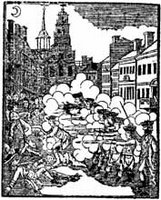Patrick Carr: breeches-maker, Massacre victim
 On 14 March 1770, a young Irish immigrant named Patrick Carr died in Boston. He had been shot on the 5th, and thus became the fifth (and by most counts the last) fatal casualty of the Boston Massacre.
On 14 March 1770, a young Irish immigrant named Patrick Carr died in Boston. He had been shot on the 5th, and thus became the fifth (and by most counts the last) fatal casualty of the Boston Massacre.
On the H-OIEAHC email list, someone recently asked why we don’t know more about Patrick Carr. I replied that we know very little about any working-man of the time. In fact, we know more about Carr than about most men of his circumstances because of how he died.
Shortly after the Massacre, Boston’s newspapers had described Carr this way:
Mr. Patrick Carr, about 30 Years of Age, who worked with Mr. Field, Leather-Breeches-Maker, in Queen-Street, wounded; a Ball entered near his Hip, and went out at his Side.The records of King’s Chapel, from which he was buried, also gave his age as thirty.
Dr. John Jeffries, one of the surgeons who treated Carr’s wounds, testified in the soldiers’ trial, adding a few more details about the man:
he was a native of Ireland, that he had frequently seen mobs, and soldiers called upon to quell them: whenever he mentioned that, he always called himself a fool, that he might have known better, that he had seen soldiers often fire on the people in Ireland, but had never seen them bear half so much before they fired in his life.In addition, Jeffries said that Carr told him he had left Field’s house when the church bells rang, and was “carried home to Mr. Field’s by some of his friends” afterward.
We also have the trial testimony of Mrs. Catherine Field and John Mansfield, who preceded Dr. Jeffries on the witness stand. They both testified that Catherine’s husband had told Carr, his employee and tenant, not to go out with a sword under his coat. But only an unnamed neighbor woman was able to convince Carr to leave that weapon behind.
Inspired by success in identifying the employer of another Massacre victim, I did a little digging on “Mr. Field, Leather-Breeches-Maker.” Leather breeches were a standard garment for working-men and for boys of all classes, so there was a steady trade in them. It didn’t take long to find records of a man in that business named John Field. In February 1772 he joined the Charitable Irish Society of Boston; most of its members seem to have been immigrants from Ireland, so he might well have been one, too.
In Oct 1770 several Boston newspapers carried this advertisement:
John Field,George R. T. Hewes, whose memory had proven reliable in many details, recalled Carr’s employer as living “on Prison Lane,” the west end of Queen Street (modern Court Street). So in March 1770 John Field and his household were only a couple of blocks from the site of the Massacre at most. Then at the end of the year they moved around the corner onto Cornhill. (I’m digging deeper into the Fields’ life, and have found some strange holes to discuss sometime.)
Breeches-marker and Glover—takes this Opportunity to Acquaint the Publick, that he as removed from the House he lately lived in, in Queen-street, opposite to the Old Brick Meeting-House, near the Town-House, where he has a large parcel of the best Buck and Doe skin Breeches, and a large Assortment of the best Gloves, which he means to sell by Wholesale or Retail; such Gentlemen as are pleased to favour him with their Custom, may depend on having their Work done in the neatest and best Manner.
Someone’s created a Wikipedia article about Patrick Carr with:
- a middle name, which was quite rare in the 1700s for lower- and middling-class men.
- famous descendants, though there’s no hint from Boston records that he was married or had children.
- a botched transcription of the testimony about him at the soldiers’ trial (since improved).

No comments:
Post a Comment